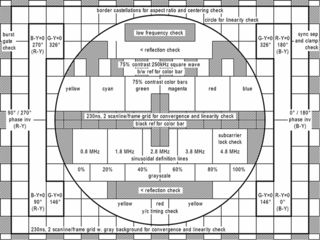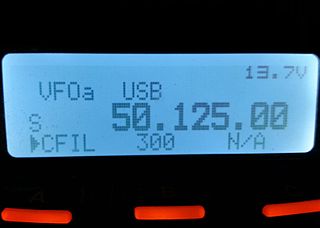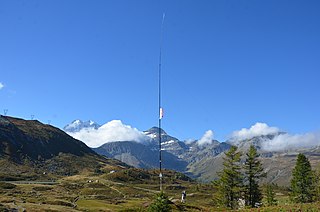
Shortwave radio is radio transmission using radio frequencies in the shortwave bands (SW). There is no official definition of the band range, but it always includes all of the high frequency band (HF), which extends from 3 to 30 MHz ; above the medium frequency band (MF), to the bottom of the VHF band.

Very high frequency (VHF) is the ITU designation for the range of radio frequency electromagnetic waves from 30 to 300 megahertz (MHz), with corresponding wavelengths of ten meters to one meter. Frequencies immediately below VHF are denoted high frequency (HF), and the next higher frequencies are known as ultra high frequency (UHF).

Medium frequency (MF) is the ITU designation for radio frequencies (RF) in the range of 300 kilohertz (kHz) to 3 megahertz (MHz). Part of this band is the medium wave (MW) AM broadcast band. The MF band is also known as the hectometer band as the wavelengths range from ten to one hectometers. Frequencies immediately below MF are denoted as low frequency (LF), while the first band of higher frequencies is known as high frequency (HF). MF is mostly used for AM radio broadcasting, navigational radio beacons, maritime ship-to-shore communication, and transoceanic air traffic control.

High frequency (HF) is the ITU designation for the band of radio waves with frequency between 3 and 30 megahertz (MHz). It is also known as the decameter band or decameter wave as its wavelengths range from one to ten decameters. Frequencies immediately below HF are denoted medium frequency (MF), while the next band of higher frequencies is known as the very high frequency (VHF) band. The HF band is a major part of the shortwave band of frequencies, so communication at these frequencies is often called shortwave radio. Because radio waves in this band can be reflected back to Earth by the ionosphere layer in the atmosphere – a method known as "skip" or "skywave" propagation – these frequencies can be used for long-distance communication across intercontinental distances and for mountainous terrains which prevent line-of-sight communications. The band is used by international shortwave broadcasting stations (3.95–25.82 MHz), aviation communication, government time stations, weather stations, amateur radio and citizens band services, among other uses.

Amateur television (ATV) is the transmission of broadcast quality video and audio over the wide range of frequencies of radio waves allocated for radio amateur (Ham) use. ATV is used for non-commercial experimentation, pleasure, and public service events. Ham TV stations were on the air in many cities before commercial television stations came on the air. Various transmission standards are used, these include the broadcast transmission standards of NTSC in North America and Japan, and PAL or SECAM elsewhere, utilizing the full refresh rates of those standards. ATV includes the study of building of such transmitters and receivers, and the study of radio propagation of signals travelling between transmitting and receiving stations.
The 70-centimeter or 440 MHz band is a portion of the UHF radio spectrum internationally allocated to amateur radio and amateur satellite use. The ITU amateur radio allocation is from 430 to 440 MHz; however, some countries, such as the United States, allocate hams 420 to 450 MHz. Depending on the country the band is shared with other radio services.

The 6-meter band is the lowest portion of the very high frequency (VHF) radio spectrum internationally allocated to amateur radio use. The term refers to the average signal wavelength of 6 meters.
The 80 meter or 3.5 MHz band is a span of radio frequencies allocated for amateur use, from 3.5–4.0 MHz in North and South America ; generally 3.5–3.8 MHz in Europe, Africa, and northern Asia (Region 1); and 3.5–3.9 MHz in south and east Asia and the eastern Pacific (Region 3). The upper portion of the band, which is usually used for phone (voice), is sometimes referred to as 75 meters; however, in Europe, "75 m" is used to name an overlapping shortwave broadcast band between 3.9–4.0 MHz used by a number of national radio services.
Shortwave bands are frequency allocations for use within the shortwave radio spectrum. Radio waves in these frequency ranges can be used for very long distance (transcontinental) communication because they can reflect off layers of charged particles in the ionosphere and return to Earth beyond the horizon, a mechanism called skywave or “skip” propagation. They are allocated by the ITU for radio services such as maritime communications, international shortwave broadcasting and worldwide amateur radio. The bands are conventionally named by their wavelength in metres, for example the ‘20 meter band’. Radio propagation and possible communication distances vary depending on the time of day, the season and the level of solar activity.

The 40-meter or 7-MHz band is an amateur radio frequency band, spanning 7.000-7.300 MHz in ITU Region 2, and 7.000-7.200 MHz in Regions 1 & 3. It is allocated to radio amateurs worldwide on a primary basis; however, only 7.000-7.200 MHz is exclusively allocated to amateur radio worldwide. Shortwave broadcasters and land mobile users also have primary allocations in some countries, and amateur stations must share the band with these users.

The 20-meter or 14-MHz amateur radio band is a portion of the shortwave radio spectrum, comprising frequencies stretching from 14.000 MHz to 14.350 MHz. The 20-meter band is widely considered among the best for long-distance communication (DXing), and is one of the most popular—and crowded—during contests. Several factors contribute to this, including the band's large size, the relatively small size of antennas tuned to it and its good potential for daytime DX operation even in unfavorable propagation conditions.
The 10-meter band is a portion of the shortwave radio spectrum internationally allocated to amateur radio and amateur satellite use on a primary basis. The band consists of frequencies stretching from 28.000 to 29.700 MHz.

The 15-meter band is an amateur radio frequency band spanning the shortwave spectrum from 21 to 21.45 MHz. The band is suitable for amateur long-distance communications, and such use is permitted in nearly all countries.

The 60-meter band or 5MHz band is a relatively new amateur radio allocation. First introduced in 2002, it was originally available in only a few countries, including the United States, United Kingdom, Norway, Finland, Denmark, Ireland and Iceland. Several decades in use, an increasing proportion of countries' telecommunications administrations – together with their government and military users – have permitted Amateur Radio operation in the 5MHz area on a short or longer-term basis, ranging from discrete channels to a frequency band allocation.
Amateur radio frequency allocation is done by national telecommunication authorities. Globally, the International Telecommunication Union (ITU) oversees how much radio spectrum is set aside for amateur radio transmissions. Individual amateur stations are free to use any frequency within authorized frequency ranges; authorized bands may vary by the class of the station license.
The 2200-meter or 136 kHz band is the lowest frequency band in which amateur radio operators are licensed to transmit. It was formally allocated to amateurs at the 2007 World Radiocommunication Conference (WRC-07). The band is available on a secondary basis in all ITU regions with the limitation that amateur stations have maximum radiated power of 1 watt effective isotropic radiated power.
The World Administrative Radio Conference (WARC) bands are three portions of the shortwave radio spectrum used by licensed and/or certified amateur radio operators. They consist of 30 meters (10.1–10.15 MHz), 17 meters (18.068–18.168 MHz), and 12 meters (24.89–24.99 MHz). They were named after the World Administrative Radio Conference, which in 1979 created a worldwide allocation of these bands for amateur use. The bands were opened for use in the early 1980s. Due to their relatively small bandwidth of 100 kHz or less, there is a gentlemen's agreement that the WARC bands may not be used for general contesting. This agreement has been codified in official recommendations, such as the IARU Region 1 HF Manager's Handbook, which states: "Contest activity shall not take place on the 5, 10, 18 and 24 MHz bands."
An amateur radio propagation beacon is a radio beacon, whose purpose is the investigation of the propagation of radio signals. Most radio propagation beacons use amateur radio frequencies. They can be found on LF, MF, HF, VHF, UHF, and microwave frequencies. Microwave beacons are also used as signal sources to test and calibrate antennas and receivers.
The 5-meter band (60 MHz) is the middle portion of the very high frequency (VHF) radio spectrum allocated to amateur radio use.
The 8–meter band (40 MHz) is at present the lowest portion of the very high frequency (VHF) radio spectrum available for national amateur radio use. The term refers to the average signal wavelength of 8 meters.









